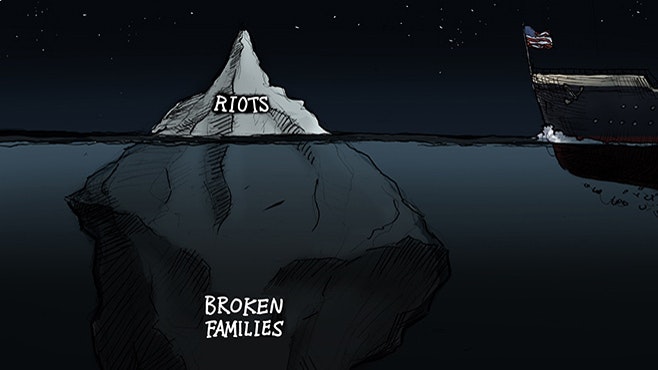By Dr. Glenn Arbery, President, Wyoming Catholic College
In a recent Daily Cartoon for the New Yorker, cartoonist Elizabeth McNair depicts an old bearded white man with his eyes closed — the familiar doomsday prophet — holding up a sign that reads THE END IS NEAR. Around the corner behind him comes an open-eyed and determined-looking young black woman holding up a sign that says ACTUALLY, THIS IS JUST THE BEGINNING.
McNair presents a quick and simple interpretation of the national turmoil we now face. First of all, it is racially divided, old white man versus young black woman. Whiteness, very much including the white beard of old age, is an embattled order that feels a more or less apocalyptic dread of the end of civilization.
Given the biblical associations with prophecy, the cartoon hints at this benighted antique figure’s understanding of moral order. Note his closed eyes. Blackness, by contrast, is embodied in the determined countenance of the young woman. Her life matters. Forward-looking, wholly oriented toward the future, she does not anticipate doomsday, but some brighter and better tomorrow where her personal ambitions have been liberated from the oppressive past. Her race and gender will not hinder her.
Looking at this cartoon, I am reminded of another one that I saw this week, this one by Pat Cross in the National Catholic Register.Playing on another familiar cartoon theme, the Titanic and the iceberg, Cross depicts a massive iceberg of which “Riots” are merely the small, visible tip. “Broken Families” are the massive, unseen part of the iceberg toward which a ship flying the U.S. flag is blithely steaming.
Cross does not emphasize the peaceful demonstrations implied in McNair’s cartoon, but the symptomatic civil disorder that these demonstrations unleash. Race is not the overt reference of his cartoon. The hidden part of the iceberg applies across all racial divides, since (to cite the common statistics) 40% of all children in the United States are now born out of wedlock, and 50% of marriages end in divorce.
But in the current circumstances, Cross’s word “Riots” might easily be interpreted to mean “black lawlessness” and “Broken Families” might suggest the cause of lawlessness: the fact that 77% of all black children in the United States are now born out of wedlock.
What do “broken families” have to do with the murder of George Floyd, the insistence that black lives matter, the charge of systemic racism, and the brutality of the police? For Cross, black lives matter so much that the restoration of families must be the crucial first step in acknowledging the great wrong that began with race slavery.
Why?
Because stable relationships between a mother and a father, their mutual trust, and their love of their children provide a strong moral grounding, a sense of ownership in the present, and solid expectations for the future. If, on the other hand, a child’s primary experience is abandonment and illegitimacy, he or she will have no deeply felt reason to respect law itself or enforcers of the law. If black people encounter “law” as an instrument of deprivation and violence, why not resist it? If “law” is merely oppression enacted by policemen who serve “whiteness,” then any so-called common good that law promises has already been denied to black people in advance.
Pat Cross, looking at the reality of the rejection of marriage, believes that healing broken families is the least racist thing America can do. For McNair, on the other hand, “just the beginning” means that the defeat of the old doomsday prophet is the condition of personal liberation in the new America she envisions.
I understand very well the appeal of being able to say, “Actually, this is just the beginning.” In fact, I say it about Wyoming Catholic College, both in its founding purpose and its future. I do not associate that new beginning with liberation from the best of the past, however, but rather with its deeper and more thoughtful recovery, with the acknowledgment of past wrongs and the genuine attempt at redress. What is permanently true will reemerge. Christ is risen. What is false or merely ideological will inevitably fall away.
There is much to examine in our own hearts about how we treat others, much to repent. But McNair’s young, determined, black woman is convinced, like many in my generation in the 1960s (or French Revolutionaries in the 1790s), that the old repressive human condition can at last be remedied through enlightened social action.
That action now appears to entail a great and growing contempt for America itself, our hard-won Republic, as inherently flawed; it appears to interpret the world’s greatest ongoing endeavor of self-government as an evil thing from the moment that Columbus set sail from Europe. A young writer in Brooklyn, Robert Jones, Jr., writes that “The United States of America is by its very nature, anti-Black…. [Anti-Blackness] is the foundation of every American institution and what animates every American person.”
The title of his piece is “Let It Burn.” No wonder statues are toppled, churches violated, public officials derided or removed for trying to maintain public order.
If this is actually just the beginning, no wonder the old prophet, who has seen many a revolution like this one, says what he does. He closes his eyes because he sees all too well what is coming.





